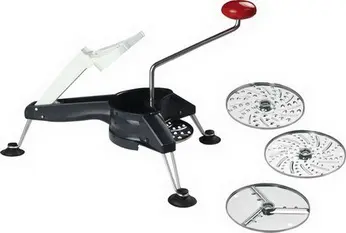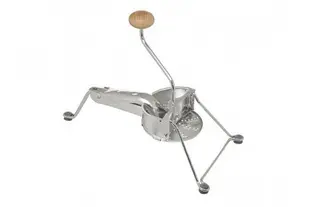This site uses only a few technical cookies necessary for its operation. By continuing to browse, you accept their use.
To find out more...
To find out more...
The return of the vegetable grater

If you are of a certain age (say +50) you may have known, when you were a kid, something that your grandmother had in her kitchen set, the vegetable grater.
A kind of mill, to be turned by hand, and which with cutting discs of different sizes, allowed to grate a lot of vegetables, carrots first in my memory, and then all the others.
A kind of mill, to be turned by hand, and which with cutting discs of different sizes, allowed to grate a lot of vegetables, carrots first in my memory, and then all the others.
17 K 4.6/5 (23 reviews)
Keywords for this post:VegetablesGraterUtensilToolMaterialLast modified on: March 20th 2021
The return of the vegetable grater
In my memory, it was a big metal thing that could be bought on the markets (from the guy who sold a bewildering number of knives and savers), you needed a certain amount of grip to use it, but it grated pretty much anything and it looked a lot like this:
Over time, like almost everything else that was manual for that matter, it disappeared, replaced by robots, robo-cutters, or electric graters, which are much easier to operate.
The problem with food processors is that they run very fast, too fast even to grate properly, and that they have an annoying tendency to make very thin, very small pieces, too much I think, and on top of that to produce a bit of juice.
For a raw carrot or beet salad, it's not too bad, but for celery (future celery remoulade) or potatoes (future potatoes) or cooked vegetables, it's not good at all, it's much too thin, almost crushed, whereas in these 2 cases at least, you want long and well shaped pieces.
The manufacturers of kitchen equipment have of course reacted since a long time, and propose electric graters, which turn more slowly, and give good results it is necessary to recognize it.
But at the same time, we are witnessing a comeback of grandma's vegetable grater, entirely manual, but in more modern materials (stainless steel, plastic), never breaks down, consumes 0 kw, and is easily washed under water
It's often a good option to go back to the basics, to the things that stand the test of time, and the vegetable grater is one of them.
- If you already have "something that turns fast" like a food processor, it's really worth it to switch to a vegetable grater, and it's not necessary to get an electric one. A manual grater, like the one above, costs about 20 euros, and is very suitable for a family.
Be careful though, don't get a cheap grater, made of fragile plastic, which will break quite quickly. As always for the material, you have to pay the price, it is an investment in time.
The price is forgotten, the quality remains.
We realize that 50 years later, some of our grandmother's tools still work very well, and that we have not done better since.
Same thing for the vegetable mill, but it is another subject...
You've probably noticed that I'm very attached to cooking with children, I often talk about it, convinced that it's the first and most efficient way to fight junk food.
Well, you can very well entrust children with the manual vegetable grater, they don't risk hurting themselves, and the effort to be made is rewarding for them (a little discreet help can sometimes be necessary).
They will be proud to help prepare the carrot salad, next Sunday's starter.
To sum up: To grate vegetables, nothing beats a good manual grater.

Over time, like almost everything else that was manual for that matter, it disappeared, replaced by robots, robo-cutters, or electric graters, which are much easier to operate.

The problem with food processors is that they run very fast, too fast even to grate properly, and that they have an annoying tendency to make very thin, very small pieces, too much I think, and on top of that to produce a bit of juice.
For a raw carrot or beet salad, it's not too bad, but for celery (future celery remoulade) or potatoes (future potatoes) or cooked vegetables, it's not good at all, it's much too thin, almost crushed, whereas in these 2 cases at least, you want long and well shaped pieces.
The manufacturers of kitchen equipment have of course reacted since a long time, and propose electric graters, which turn more slowly, and give good results it is necessary to recognize it.

But at the same time, we are witnessing a comeback of grandma's vegetable grater, entirely manual, but in more modern materials (stainless steel, plastic), never breaks down, consumes 0 kw, and is easily washed under water

It's often a good option to go back to the basics, to the things that stand the test of time, and the vegetable grater is one of them.
What to choose?
- If you already have an electric grater, don't change anything, or if you're looking to save energy, switch to a manual grater.- If you already have "something that turns fast" like a food processor, it's really worth it to switch to a vegetable grater, and it's not necessary to get an electric one. A manual grater, like the one above, costs about 20 euros, and is very suitable for a family.
Be careful though, don't get a cheap grater, made of fragile plastic, which will break quite quickly. As always for the material, you have to pay the price, it is an investment in time.
The price is forgotten, the quality remains.
We realize that 50 years later, some of our grandmother's tools still work very well, and that we have not done better since.
Same thing for the vegetable mill, but it is another subject...
You've probably noticed that I'm very attached to cooking with children, I often talk about it, convinced that it's the first and most efficient way to fight junk food.
Well, you can very well entrust children with the manual vegetable grater, they don't risk hurting themselves, and the effort to be made is rewarding for them (a little discreet help can sometimes be necessary).
They will be proud to help prepare the carrot salad, next Sunday's starter.
To sum up: To grate vegetables, nothing beats a good manual grater.
Lasts posts
Butter vs. grease
We often read in a recipe where a pastry is put into a mould that, just before pouring, the mould should be buttered or greased. But what's the difference between these 2 terms?December 1st 20259875
Getting out of the fridge early
Very often when you're cooking, you need to take food or preparations out of the fridge, to use them in the recipe in progress. There's nothing tricky about this: you just take them out of the fridge and use them, usually immediately, in the recipe. But is this really a good method?November 24th 20251,1205
Who's making the croissants?
When you look at a bakery from the outside, you naturally think that in the bakery, the bakers make the bread, and in the laboratory, the pastry chefs make the cakes. It's very often like that, with each of these professions having quite different ways of working, but sometimes there's also one...November 23th 20251,012
Oven height
When we put a dish or cake in the oven, we naturally tend to put it on the middle shelf, and that's what we usually do. But in some cases, this position and height can be a little tricky, so let's find out why.October 8th 20252,7475
The importance of sieving
In recipes that use a fine powder (flour, powdered sugar, etc.), you'll often see the advice to sift before using it. To sift is to pass the powder in question through a sieve (a very fine strainer) before incorporating it into your recipe. It's often advice, but is it really useful?September 3rd 20257,5323
Other pages you may also like
Stand mixer tools
Whether we call it a stand mixer, food processor, or simply refer to it by brand (Kenwood, KitchenAid, etc.), this machine is a valuable tool for amateur cooks, bakers or pastry chefs like ourselves. All these machines come supplied with 3 different tools. Let’s take a look at their names and...November 2nd 201938 K4.5
A few tips for effective kneading at home
When you have to knead dough for bread or some other recipe, you may well use a food processor or the type of machine known as a stand mixer. The best-known brands are Kenwood and KitchenAid. They are useful tools, but here are a few tips to help you get the best out of them.June 23th 2021284 K 23.8
Should I believe my oven?
Can you really trust your oven? This is an important question as we are always tempted to take the temperature indicated as gospel truth and, unfortunately, this is rarely very precise. .July 4th 201133 K4.6
Fruits which can ruin your jelly
There are many ways of making a fruit mousse, but one of the simplest is to prepare a fruit jelly (basically a fresh fruit coulis with gelatine) and then mix this jelly before it sets completely with whipped cream. The result is perfect for filling a charlotte, for example. But do beware;...March 6th 201378 K4.0
The window-pane test in bread-making
The home bread-makers often ask themselves “Have I kneaded my dough long enough?” . A good question, as dough that is insufficiently kneaded will not rise properly or will fall flat when the top is slashed, which is very frustrating. To know when the dough is ready, one can rely on the length...June 16th 202196 K 23.9
Post a comment or question
Follow this page
If you are interested in this page, you can "follow" it, by entering your email address here. You will then receive a notification immediately each time the page is modified or a new comment is added. Please note that you will need to confirm this following.
Note: We'll never share your e-mail address with anyone else.
Alternatively: you can subscribe to the mailing list of cooling-ez.com , you will receive a e-mail for each new recipe published on the site.









